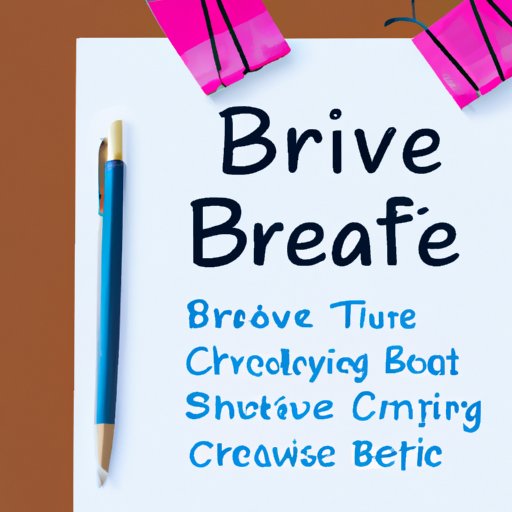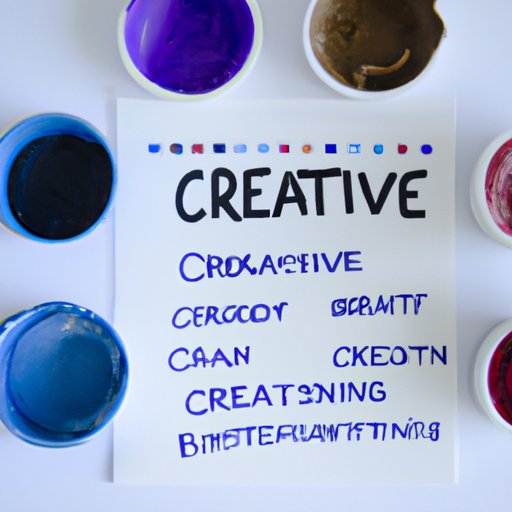Introduction
A creative brief is an essential document in the creative process. It provides detailed information about a project’s objectives, target audience, brand guidelines and other key elements that help guide the creative process. Its purpose is to ensure that all stakeholders are on the same page and have a clear understanding of what they need to accomplish. This article will explore what a creative brief is, its purpose, types, elements, benefits and tips for crafting an impactful creative brief. It will also examine the role of creative briefs in the creative process and their relationship to creativity.

Defining Creative Briefs: An Overview
A creative brief is a document that outlines the goals, objectives and key elements of a creative project. It acts as a roadmap for everyone involved in the creative process and helps keep them focused on the end goal. The purpose of a creative brief is to ensure that all stakeholders understand the project requirements and can work together to achieve the desired results. In order to write an effective creative brief, it is important to understand what it is and the different types of creative briefs available.
What is a Creative Brief?
A creative brief is a document that outlines the goals, objectives and key elements of a creative project. It is used to communicate the project’s purpose, target audience, brand guidelines and other important details to the team responsible for executing the project. A creative brief should be concise and easy to understand so that everyone involved in the project has a clear understanding of what needs to be done. It should also provide enough detail to ensure that the project is completed successfully.
Different Types of Creative Briefs
There are four main types of creative briefs: traditional, experiential, digital and integrated. Each type of creative brief is designed to meet the specific needs of the project and provide guidance to the creative team. Traditional creative briefs are typically used for advertising campaigns, experiential briefs are used for live events, digital briefs are used for online projects and integrated briefs are used for projects that span multiple channels. Understanding the different types of creative briefs is essential to writing an effective one.

How to Write an Effective Creative Brief
Writing an effective creative brief is essential to ensuring that the project is successful. It should provide enough detail to enable the creative team to do their job while also leaving room for creativity. There are certain elements that should be included in every creative brief and some tips to follow when crafting an impactful one.
Elements to Include in a Creative Brief
The following elements should be included in every creative brief: goal and objective, target audience, brand guidelines, creative direction, budget and timeline. These elements provide the creative team with the necessary information to execute the project successfully.
Benefits of Using a Creative Brief
Using a creative brief offers numerous benefits. It helps focus the creative team on the end result and streamlines the creative process by providing a clear set of instructions. It also ensures that all stakeholders are on the same page and have a clear understanding of the project expectations.
Tips for Crafting an Impactful Creative Brief
When crafting an effective creative brief, there are a few tips to keep in mind. Keep it simple and concise and avoid using industry jargon. Ask questions to gain a better understanding of the project’s goals and objectives. Use visual aids such as images or diagrams to make the brief more impactful. Finally, make sure to include any relevant information that may be useful to the creative team.
Analyzing the Different Types of Creative Briefs
As mentioned earlier, there are four main types of creative briefs: traditional, experiential, digital and integrated. Each type of creative brief has its own unique elements and should be tailored to the specific needs of the project. Let’s take a closer look at each type of creative brief.
Traditional Creative Brief
A traditional creative brief is typically used for advertising campaigns. It should include a description of the product or service being advertised, the target audience, the campaign message and any other relevant information. This type of brief should also include the budget and timeline for the project.
Experiential Creative Brief
An experiential creative brief is used for live events such as conferences, workshops and trade shows. It should include the event’s purpose, target audience, format and any other relevant information. This type of brief should also include the budget and timeline for the project.
Digital Creative Brief
A digital creative brief is used for online projects such as websites, apps and digital campaigns. It should include the project’s purpose, target audience, platform and any other relevant information. This type of brief should also include the budget and timeline for the project.
Integrated Creative Brief
An integrated creative brief is used for projects that span multiple channels such as print, television, radio and digital. It should include the project’s purpose, target audience, platforms and any other relevant information. This type of brief should also include the budget and timeline for the project.
What Elements Should be Included in a Creative Brief?
In order to write an effective creative brief, there are certain elements that should be included. These elements provide the necessary information to enable the creative team to do their job and ensure that the project is completed successfully.
Goal and Objective
The goal and objective of the project should be clearly stated in the creative brief. This will help the creative team understand what they need to accomplish and ensure that the project is completed on time and within budget.
Target Audience
The target audience for the project should also be included in the creative brief. Knowing who the project is aimed at will help the creative team create content that resonates with the intended audience.
Brand Guidelines
The creative brief should also include any brand guidelines that need to be followed. This will ensure that the project meets the standards set by the company and aligns with the brand’s overall identity.
Creative Direction
The creative brief should also include any creative direction that needs to be taken. This will help the creative team understand the project’s overall vision and ensure that the final product reflects the desired outcome.
Budget and Timeline
Finally, the creative brief should include the budget and timeline for the project. This will help the creative team stay on track and complete the project within the allotted time and budget.
Benefits of Using a Creative Brief
Using a creative brief offers numerous benefits. It helps focus the creative team on the end result and streamlines the creative process by providing a clear set of instructions. It also ensures that all stakeholders are on the same page and have a clear understanding of the project expectations.
Focus on the End Result
Using a creative brief helps ensure that the project is completed successfully by keeping the creative team focused on the end result. It eliminates guesswork and allows the team to stay on track throughout the entire process.
Streamlined Creative Process
A creative brief also streamlines the creative process by providing a clear set of instructions. This eliminates confusion and ensures that everyone involved in the project understands their role and the expectations for the project.
Tips for Crafting an Impactful Creative Brief
When crafting an effective creative brief, there are a few tips to keep in mind. Keep it simple and concise and avoid using industry jargon. Ask questions to gain a better understanding of the project’s goals and objectives. Use visual aids such as images or diagrams to make the brief more impactful. Finally, make sure to include any relevant information that may be useful to the creative team.

Creative Briefs and the Creative Process
Creative briefs play an important role in the creative process. They provide the necessary information to enable the creative team to do their job and ensure that the project is completed successfully. They also help foster creativity by providing a framework to work within.
The Role of Creative Briefs in the Creative Process
Creative briefs provide the creative team with the necessary information to do their job. They help focus the team on the end result and provide a clear set of instructions to ensure that the project is completed successfully. They also help eliminate confusion and ensure that everyone involved in the project understands their role and the expectations for the project.
The Relationship Between Creative Briefs and Creativity
Creative briefs can also help foster creativity. While they provide a framework to work within, they also allow for flexibility and encourage the creative team to think outside the box. By providing enough structure to keep the team on track while also leaving room for creativity, creative briefs can help produce innovative and impactful results.
Conclusion
A creative brief is an essential document in the creative process. It provides detailed information about a project’s objectives, target audience, brand guidelines and other key elements that help guide the creative process. Its purpose is to ensure that all stakeholders are on the same page and have a clear understanding of what they need to accomplish. This article explored what a creative brief is, its purpose, types, elements, benefits and tips for crafting an impactful creative brief. It also examined the role of creative briefs in the creative process and their relationship to creativity.
(Note: Is this article not meeting your expectations? Do you have knowledge or insights to share? Unlock new opportunities and expand your reach by joining our authors team. Click Registration to join us and share your expertise with our readers.)
